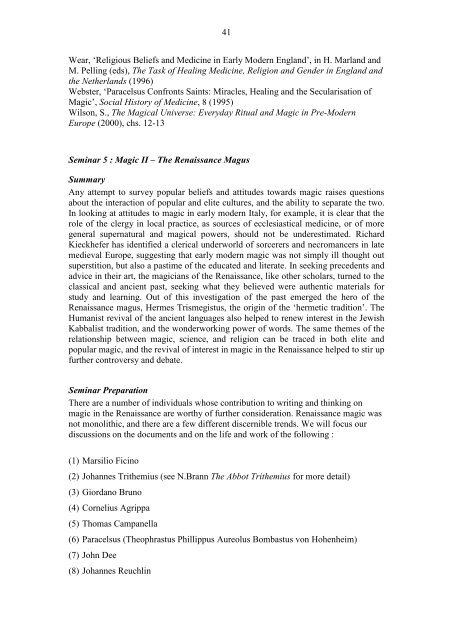Ritual, Myth and Magic in Early Modern Europe - University of Reading
Ritual, Myth and Magic in Early Modern Europe - University of Reading
Ritual, Myth and Magic in Early Modern Europe - University of Reading
You also want an ePaper? Increase the reach of your titles
YUMPU automatically turns print PDFs into web optimized ePapers that Google loves.
41<br />
Wear, ‗Religious Beliefs <strong>and</strong> Medic<strong>in</strong>e <strong>in</strong> <strong>Early</strong> <strong>Modern</strong> Engl<strong>and</strong>‘, <strong>in</strong> H. Marl<strong>and</strong> <strong>and</strong><br />
M. Pell<strong>in</strong>g (eds), The Task <strong>of</strong> Heal<strong>in</strong>g Medic<strong>in</strong>e, Religion <strong>and</strong> Gender <strong>in</strong> Engl<strong>and</strong> <strong>and</strong><br />
the Netherl<strong>and</strong>s (1996)<br />
Webster, ‗Paracelsus Confronts Sa<strong>in</strong>ts: Miracles, Heal<strong>in</strong>g <strong>and</strong> the Secularisation <strong>of</strong><br />
<strong>Magic</strong>‘, Social History <strong>of</strong> Medic<strong>in</strong>e, 8 (1995)<br />
Wilson, S., The <strong>Magic</strong>al Universe: Everyday <strong>Ritual</strong> <strong>and</strong> <strong>Magic</strong> <strong>in</strong> Pre-<strong>Modern</strong><br />
<strong>Europe</strong> (2000), chs. 12-13<br />
Sem<strong>in</strong>ar 5 : <strong>Magic</strong> II – The Renaissance Magus<br />
Summary<br />
Any attempt to survey popular beliefs <strong>and</strong> attitudes towards magic raises questions<br />
about the <strong>in</strong>teraction <strong>of</strong> popular <strong>and</strong> elite cultures, <strong>and</strong> the ability to separate the two.<br />
In look<strong>in</strong>g at attitudes to magic <strong>in</strong> early modern Italy, for example, it is clear that the<br />
role <strong>of</strong> the clergy <strong>in</strong> local practice, as sources <strong>of</strong> ecclesiastical medic<strong>in</strong>e, or <strong>of</strong> more<br />
general supernatural <strong>and</strong> magical powers, should not be underestimated. Richard<br />
Kieckhefer has identified a clerical underworld <strong>of</strong> sorcerers <strong>and</strong> necromancers <strong>in</strong> late<br />
medieval <strong>Europe</strong>, suggest<strong>in</strong>g that early modern magic was not simply ill thought out<br />
superstition, but also a pastime <strong>of</strong> the educated <strong>and</strong> literate. In seek<strong>in</strong>g precedents <strong>and</strong><br />
advice <strong>in</strong> their art, the magicians <strong>of</strong> the Renaissance, like other scholars, turned to the<br />
classical <strong>and</strong> ancient past, seek<strong>in</strong>g what they believed were authentic materials for<br />
study <strong>and</strong> learn<strong>in</strong>g. Out <strong>of</strong> this <strong>in</strong>vestigation <strong>of</strong> the past emerged the hero <strong>of</strong> the<br />
Renaissance magus, Hermes Trismegistus, the orig<strong>in</strong> <strong>of</strong> the ‗hermetic tradition‘. The<br />
Humanist revival <strong>of</strong> the ancient languages also helped to renew <strong>in</strong>terest <strong>in</strong> the Jewish<br />
Kabbalist tradition, <strong>and</strong> the wonderwork<strong>in</strong>g power <strong>of</strong> words. The same themes <strong>of</strong> the<br />
relationship between magic, science, <strong>and</strong> religion can be traced <strong>in</strong> both elite <strong>and</strong><br />
popular magic, <strong>and</strong> the revival <strong>of</strong> <strong>in</strong>terest <strong>in</strong> magic <strong>in</strong> the Renaissance helped to stir up<br />
further controversy <strong>and</strong> debate.<br />
Sem<strong>in</strong>ar Preparation<br />
There are a number <strong>of</strong> <strong>in</strong>dividuals whose contribution to writ<strong>in</strong>g <strong>and</strong> th<strong>in</strong>k<strong>in</strong>g on<br />
magic <strong>in</strong> the Renaissance are worthy <strong>of</strong> further consideration. Renaissance magic was<br />
not monolithic, <strong>and</strong> there are a few different discernible trends. We will focus our<br />
discussions on the documents <strong>and</strong> on the life <strong>and</strong> work <strong>of</strong> the follow<strong>in</strong>g :<br />
(1) Marsilio Fic<strong>in</strong>o<br />
(2) Johannes Trithemius (see N.Brann The Abbot Trithemius for more detail)<br />
(3) Giordano Bruno<br />
(4) Cornelius Agrippa<br />
(5) Thomas Campanella<br />
(6) Paracelsus (Theophrastus Phillippus Aureolus Bombastus von Hohenheim)<br />
(7) John Dee<br />
(8) Johannes Reuchl<strong>in</strong>

















